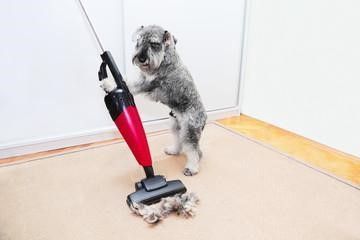Maintenance of Pet Hair Vacuum Cleaner
Table of Contents
Maintenance of Pet Hair Vacuum Cleaner

In a dog-eat-dog world, no vacuum is harmless. I know—I have three of them (dogs, not vacuums). Don’t let those sweet faces fool you; our family pooches have inadvertently demolished multiple vacuums. Not even the top-of-the-line vacuum stood up to these (adorable) beasts and their endless, insidious shedding.
I went through four vacuums before I realized how significant routine vacuum maintenance is for pet owners. Pet hair gets tangled around rollers and wheels, making belts to snap. Pet dander clogs filters and tubes. So just like our hairy friends, our vacuums need love, too!
Here are a few things I’ve learned regarding protecting your vacuum from pet hair. And some guidelines to rescue your vacuum if it gets choked up on Fluff’s fur.
Groom Yourself and Your Animal
The more hair that’s brushed out, the less that lands on the floor, saving your vacuum from a dangerous death.
Vacuum Frequently
Don’t wait for a long time to vacuum. Dirty floors with loads of pet hair make your vacuum work harder.
Use the Right Tools
If you just brushed your fur baby, don’t attempt to mow over the tufts of fur with the vacuum. Utilize the hose on the large tufts to prevent clogs and tangles on the roller.
Routine Maintenance
Consistent maintenance is key to a long vacuum life. Here are some things to consider and ways to inspect and clean your vacuum’s vital components: 
- Rollers/Brushes: Hair gets caught around the rollers and embedded in the brushes, making it difficult for your vacuum to move around. After a month or so, flip your vacuum over and inspect the brushes. Pick hair out of brushes and cut tangles free from the roller. It’s a little boring, but worth it to keep your floors fur-free (and your vacuum working.)
- Filter: Filters get dirty fast when you’re cleaning up after pets. If the filter is clogged, it can make the vacuum smell like a wet dog, and the vent may not be able to cool the motor. Pet dander can result in allergy problems, too, so be sure to replace or clean your filter regularly.
- Belt: The belt is what shoves the rollers. When hair is tangled on the rollers, the belt can snap! If your vacuum is difficult to push, stop, unplug it, flip it over, and inspect the belt. If your belt is broken, it’s typically a quick fix and a cheap part to replace.
- Hose: Loss of suction could be caused by holes in the tube or hair and toy parts caught in the curve. Stretch the hose out to release clogs or—if possible—detach the hose and utilize a long tool to remove the obstruction. If you see any kinks or tears in the hose, attempt wrapping duct tape around the weak spot for a temporary fix.
- Waste Bucket: Many waste buckets have tight spots where dirt can accrue. Take a pipe cleaner or other long object to pull the dirt out of tight corners and completely clean your waste bucket.
If your vacuum is still having trouble, check out these vacuum repair and maintenance guides to help you get your vacuum going again. If you’re beyond the point of maintenance, you might require to replace some parts. More vacuum repair guides are available at Think Vacuums.




Log In
Create New Account